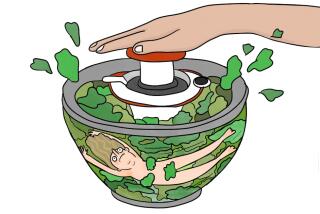Stinky Salad Bowls
- Share via
From the 1930s through the ‘60s, Americans were convinced you had to have a certain kind of bowl to make a proper green salad: a plain, unvarnished wooden bowl which could never be washed. The idea was that the wood “cured” over the years, making ever more exquisite salads. Actually, the dressing seeped into the wood and the oil turned hideously rancid, so the bowls stank to high heaven.
A sly foodie named George Rector had simply hoaxed the whole country. He’d invented the myth of the wooden salad bowl to spice up a story in the Sept. 5, 1936, issue of the Saturday Evening Post.
Playing on Americans’ fear of snobbish French gourmets, he painted green salad as the most finicky dish of all. And the secret of the perfect salad? Rubbing a clove of garlic on a wooden bowl, which would give just enough garlic flavor but not (horrors!) too much . . . and then never washing the bowl.
The French themselves had never believed any such thing. In fact, Parisian gourmets didn’t even like garlic in their salads--as Rector knew perfectly well, since he’d worked in Parisian restaurants. In his cookbooks, he had published garlic-free French salad recipes.
But this myth just pushed all sorts of buttons with Americans. Faced with a haughty French waiter, you could never go wrong ordering salad; by patiently leaving your salad bowl unwashed, you could create a gourmet masterpiece at home. So for a generation, Americans tossed salads in smelly bowls in the faith that they were steadily approaching perfection.
Rector was not a total fraud, though. Way back in the ‘30s, he was championing steamed vegetables and freshly ground pepper. In fact, his salad article also single-handedly revived the pepper mill. And that’s why American restaurants still have the odd habit of offering freshly ground pepper for salad--and not for anything else.
More to Read
Eat your way across L.A.
Get our weekly Tasting Notes newsletter for reviews, news and more.
You may occasionally receive promotional content from the Los Angeles Times.







